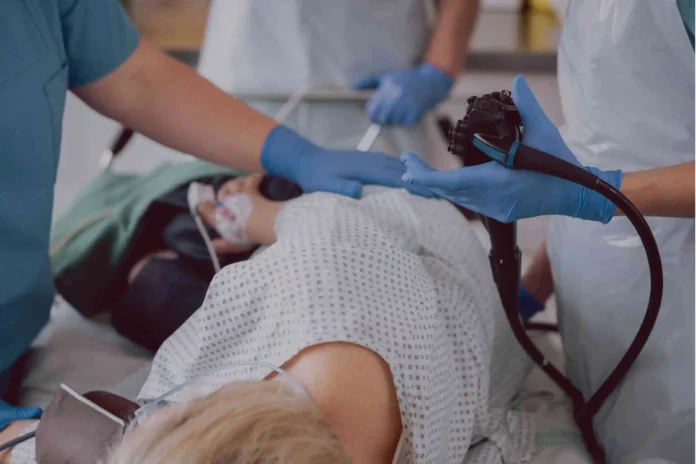The word Colonoscopy is not a bad word. Yes, the prospect of having to undergo one can produce anxiety or fear. Many people do not feel a colonoscopy is necessary because they don’t have any family history of colon cancer.
The prep is horrendous, but the procedure is painless and necessary for good health. How is a colonoscopy done? How often should one have a colonoscopy? Below are ten benefits of a colonoscopy, followed by tips on how to maintain a healthier digestive tract.
Benefits of a Colonoscopy
- The purpose of a colonoscopy is to help ascertain whether you have polyps that are precancerous or if you are in the early stages of colorectal cancer. Once identified, these polyps can be easily removed, whether they are cancerous or not. Treatment, if necessary, is greatly improved in these circumstances.
- If polyps are found in the colon, removing them during a colonoscopy will lessen your risk of developing colorectal cancer when you’re older.
- Cancer is not the only thing a doctor looks for during a colonoscopy. The doctor will look at the lining of your colon to pinpoint any abnormalities there, such as ulcerative colitis, Crohn’s, and diverticulitis. Finding these issues early and treating and managing these issues will add years to your life.
- An elderly person may have pain in the abdomen or may experience rectal bleeding. These can be due to a variety of digestive issues. A colonoscopy will help identify the cause and help your doctor offer the proper treatment.
- Chronic diarrhea or constipation for an elderly person will impact their quality of life. Again, a colonoscopy is central in identifying the cause(s) and putting the proper treatment into place.
- What if you are suffering from a blockage in your intestines? This is something a lot of elderly people experience due to tumors, polyps, or other blocks. A colonoscopy will relieve this problem and improve your health overall.
- Some medications can sometimes create gastrointestinal side effects in the elderly. Another benefit of colonoscopies is that the doctor can actually see what is happening in your intestines and take steps to intervene by recommending adjustments to your medication.
- Some senior citizens have pre-existing gastrointestinal issues requiring regular doctor visits. A routine colonoscopy will help monitor your condition and its progression. This helps the doctor recommend adjustments to your treatment if necessary.
- Colonoscopies are a pain to go through, yes. But at the end of it all, a colonoscopy will provide you with peace of mind, especially if no issues are detected. Not having to stress about some intestinal disease you may or may not have decreases stress and puts you on the road to a happier, healthier life. Your families will be grateful you are taking care of yourself!
- You must maintain good digestive health. Doing so will help keep your body functioning at its highest level. It will also influence other health matters as well. A colonoscopy is the first step in that direction.
How is a colonoscopy done?
- There is a prep period you must go through prior to your procedure. You must take a special laxative to empty your bowels. This laxative includes electrolytes to keep you from becoming dehydrated. Once you begin taking the laxative, you may not eat any solids.
Note: The FDA has recently approved a new preparation drink that is a lit tastier than what was used previously, in an attempt to get people to have regular procedures. - At the start of your procedure, you will be administered a mild sedative intravenously. Some people opt to remain awake and continue to interact with the doctor.
You will be naked from the waist down except for your surgical gown. You will lie on your left side. You will be asked to bend your legs so your knees are up towards your chest. The doctor will then insert a lubricated tube called a colonoscope (camera) into your anus to your rectum and colon. He will go up to your rectum and into your colon. If you are not anesthetized, you might feel a little bit of pain, cramping, or pressure at this time.
The imaging from the camera will appear on a monitor so that your doctor can see inside your colon and detect any issues. - The whole procedure can take up to an hour.
Aftercare
- If you were sedated for the procedure, you will have to remain in the recovery room for up to three hours. You will not be allowed to drive or go home alone afterward because you will still be groggy from the anesthesia.
Do not make any important decisions or, if you are employed, do not go back to work for the rest of the day. - You may feel bloated or pass gas for a few hours after the examination as your colon expels air. You will feel more like yourself in 24 hours. If you are in extreme abdominal pain, have a fever or chills or are experiencing dizziness, contact your doctor. These are signs of a tear and other complications.
- You can begin eating normally after 24 hours, but doctors recommend you eat foods that are gentle to your system and low in fiber. You can have fish with a sprinkling of seasoning, fruits, or white bread toast, but do not have whole grain or wheat bread!
You can also have Jello, yogurt, pudding, juices, herbal tea, plain crackers, and chicken noodle soup.
- When you feel up to it, go for a walk. This may help get rid of any discomfort you may be feeling.
Tip: You may see a tiny bit of blood in your first bowel movement after your procedure. If you become concerned, call your doctor!
As we age, our bodies begin to break down. You can slow that process down by taking care of yourself. Exercise regularly. Take that morning walk. Get some sun. You’d be surprised how beneficial a short morning walk is for you.


